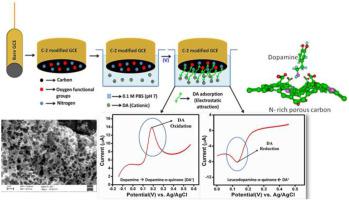当前位置:
X-MOL 学术
›
Mater. Chem. Phys.
›
论文详情
Our official English website, www.x-mol.net, welcomes your
feedback! (Note: you will need to create a separate account there.)
Synthesis of metal-free nitrogen-enriched porous carbon and its electrochemical sensing behavior for the highly sensitive detection of dopamine: Both experimental and theoretical investigation
Materials Chemistry and Physics ( IF 4.3 ) Pub Date : 2021-02-01 , DOI: 10.1016/j.matchemphys.2020.124094 Palanisamy Rupa Kasturi , Trichy Kuppusamy Aparna , Agnes Lincy Arokiyanathan , Senthilkumar Lakshmipathi , Ramanathan Sivasubramanian , Yun Sung Lee , Ramakrishnan Kalai Selvan
Materials Chemistry and Physics ( IF 4.3 ) Pub Date : 2021-02-01 , DOI: 10.1016/j.matchemphys.2020.124094 Palanisamy Rupa Kasturi , Trichy Kuppusamy Aparna , Agnes Lincy Arokiyanathan , Senthilkumar Lakshmipathi , Ramanathan Sivasubramanian , Yun Sung Lee , Ramakrishnan Kalai Selvan

|
Abstract In this study, a nitrogen-inherited foam-like porous carbon was sequestered from the starch of Artocarpus heterophyllus seeds. The obtained carbon material was used as a sustainable electrode for the electrochemical detection of dopamine biomolecule. The material exhibited a turbostratic structure, high degree of graphitization, strong carbon-nitrogen bonding, high surface area, and porous architecture. It showed good catalytic activity with a low onset potential (80 mV), wide linear responses (30–90 μM and 200–400 μM), a low limit of detection (2.74 nM), and superior sensitivity (4.64 μA μM -1cm -2). The results indicated that the porous architecture and organic functionalities on the surface provided fast electron transfer at the electrode/electrolyte interface. Moreover, it offered superior stability, reproducibility, and biocompatibility toward dopamine sensing in real samples. Furthermore, first-principle calculations were performed in both the gas and aqueous phase to determine the molecular-level interaction between the porous carbon and dopamine. The results indicated that the interaction between dopamine and the nitrogen-enriched carbon sheet was stronger (−0.64 eV) than the oxygen-rich sheet. The atoms-in-molecules analysis, charge density difference analysis, and Fukui function plots indicated a charge transfer from the biomolecules to the carbon sheet. Overall, the theoretical findings confirmed the observed experimental results.
中文翻译:

用于高灵敏度多巴胺检测的无金属富氮多孔碳的合成及其电化学传感行为:实验和理论研究
摘要 在这项研究中,一种氮继承的泡沫状多孔碳是从紫荆花种子的淀粉中分离出来的。所得碳材料用作可持续电极用于多巴胺生物分子的电化学检测。该材料表现出湍流结构、高度石墨化、强碳氮键、高表面积和多孔结构。它表现出良好的催化活性,具有低起始电位(80 mV)、宽线性响应(30-90 μM 和 200-400 μM)、低检测限(2.74 nM)和卓越的灵敏度(4.64 μA μM -1cm - 2)。结果表明,表面的多孔结构和有机功能在电极/电解质界面提供了快速的电子转移。此外,它提供了卓越的稳定性、重现性、以及对真实样品中多巴胺传感的生物相容性。此外,在气相和水相中进行了第一性原理计算,以确定多孔碳和多巴胺之间的分子级相互作用。结果表明,多巴胺与富氮碳片之间的相互作用比富氧碳片更强(-0.64 eV)。分子中的原子分析、电荷密度差异分析和 Fukui 函数图表明电荷从生物分子转移到碳片。总的来说,理论发现证实了观察到的实验结果。结果表明,多巴胺与富氮碳片之间的相互作用比富氧碳片更强(-0.64 eV)。分子中的原子分析、电荷密度差异分析和 Fukui 函数图表明电荷从生物分子转移到碳片。总体而言,理论发现证实了观察到的实验结果。结果表明,多巴胺与富氮碳片之间的相互作用比富氧碳片更强(-0.64 eV)。分子中的原子分析、电荷密度差异分析和 Fukui 函数图表明电荷从生物分子转移到碳片。总的来说,理论发现证实了观察到的实验结果。
更新日期:2021-02-01
中文翻译:

用于高灵敏度多巴胺检测的无金属富氮多孔碳的合成及其电化学传感行为:实验和理论研究
摘要 在这项研究中,一种氮继承的泡沫状多孔碳是从紫荆花种子的淀粉中分离出来的。所得碳材料用作可持续电极用于多巴胺生物分子的电化学检测。该材料表现出湍流结构、高度石墨化、强碳氮键、高表面积和多孔结构。它表现出良好的催化活性,具有低起始电位(80 mV)、宽线性响应(30-90 μM 和 200-400 μM)、低检测限(2.74 nM)和卓越的灵敏度(4.64 μA μM -1cm - 2)。结果表明,表面的多孔结构和有机功能在电极/电解质界面提供了快速的电子转移。此外,它提供了卓越的稳定性、重现性、以及对真实样品中多巴胺传感的生物相容性。此外,在气相和水相中进行了第一性原理计算,以确定多孔碳和多巴胺之间的分子级相互作用。结果表明,多巴胺与富氮碳片之间的相互作用比富氧碳片更强(-0.64 eV)。分子中的原子分析、电荷密度差异分析和 Fukui 函数图表明电荷从生物分子转移到碳片。总的来说,理论发现证实了观察到的实验结果。结果表明,多巴胺与富氮碳片之间的相互作用比富氧碳片更强(-0.64 eV)。分子中的原子分析、电荷密度差异分析和 Fukui 函数图表明电荷从生物分子转移到碳片。总体而言,理论发现证实了观察到的实验结果。结果表明,多巴胺与富氮碳片之间的相互作用比富氧碳片更强(-0.64 eV)。分子中的原子分析、电荷密度差异分析和 Fukui 函数图表明电荷从生物分子转移到碳片。总的来说,理论发现证实了观察到的实验结果。











































 京公网安备 11010802027423号
京公网安备 11010802027423号